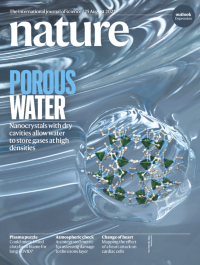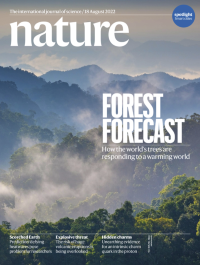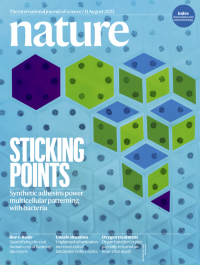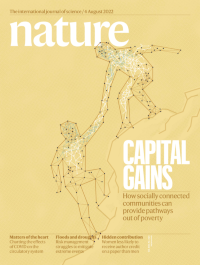Volume 608
-
No. 7924 25 August 2022
Porous waterMany gases can be dissolved in water, but the amount of gas that can be held by the liquid is relatively low. In this week’s issue, Jarad Mason and his colleagues present a system that creates permanently ‘porous’ water, allowing gases to be stored at high concentrations within the liquid. To achieve this, the researchers suspended tailored microporous nanocrystals in water and other aqueous solutions. The internal surfaces of the solids repel water molecules, thereby creating ‘dry’ pores that can readily adsorb gases from the surrounding liquid. This allowed the team to store gases, including oxygen and carbon dioxide, at much higher concentrations than is possible in water alone. The work could have implications in energy and biomedicine, because highly oxygenated water might be able to act as a solvent for electrocatalysis or a substitute for blood.
Nature Outlook
-
No. 7923 18 August 2022
Forest forecastThe cover captures the morning mist at Kaeng Krachan National Park in Thailand. Like every other aspect of life on Earth, forests are facing increased challenges posed by climate change. A collection of papers in this week’s issue probes the vulnerabilities and potential resilience of forests in a warming world. Three studies focus on North America: one examining the response of boreal species to warming and drought, another analysing the timing of stem growth in temperate deciduous forests, and a third revealing migration of white spruce (Picea glauca) into the Arctic tundra. In the tropics, one paper investigates the impact of phosphorus availability in the Amazon, while another assesses the reasons for increased mortality of tropical trees. Finally, a sixth paper shows how satellite imaging can be combined with machine learning to identify declining resilience in the world’s forests.
Spotlight
-
No. 7922 11 August 2022
Sticking pointsInterfaces between cells are created when cells stick to each other, a process usually mediated by adhesion molecules called adhesins. Engineering the formation of cell–cell interfaces and programming subsequent patterning using synthetic adhesins has proved challenging. In this week’s issue, Ingmar Riedel-Kruse and his colleagues present such a system based on synthetic adhesins in the bacterium Escherichia coli. The researchers used the four-colour theorem to mathematically and experimentally show that just four adhesins are sufficient to construct a logic to create any arbitrary interface pattern. The cover shows one such tiling pattern. Each dot corresponds to a colony of outwardly growing E. coli, and the lines are the interfaces formed when two bacteria carrying complementary adhesins meet and stick together. The adhesin logic is illustrated by the coloured shapes overlaid on part of the image. The four-adhesin toolkit could help drive the engineering of biosensors and biomaterials as well as shedding light on the evolution of multicellular systems.
-
No. 7921 4 August 2022
Capital gainsAn individual’s social network and community — their ‘social capital’ — has been thought to influence outcomes ranging from earnings to health. But measuring social capital is challenging. In two papers in this week’s issue, Raj Chetty and his colleagues use data on 21 billion friendships from Facebook to construct a Social Capital Atlas containing measures of social capital for each ZIP code, high school and college in the United States. The researchers measure three types of social capital: connectedness between different types of people, social cohesion and civic engagement. They find that children who grow up in communities where people of low and high socio-economic status interact more have substantially greater chances of rising out of poverty. The team then examines what might limit social interactions across class lines, finding a roughly equal contribution from lack of exposure — because children in different socio-economic groups go to different schools, for example — and friending bias, the tendency for people to befriend people similar to them.
Focal Point




